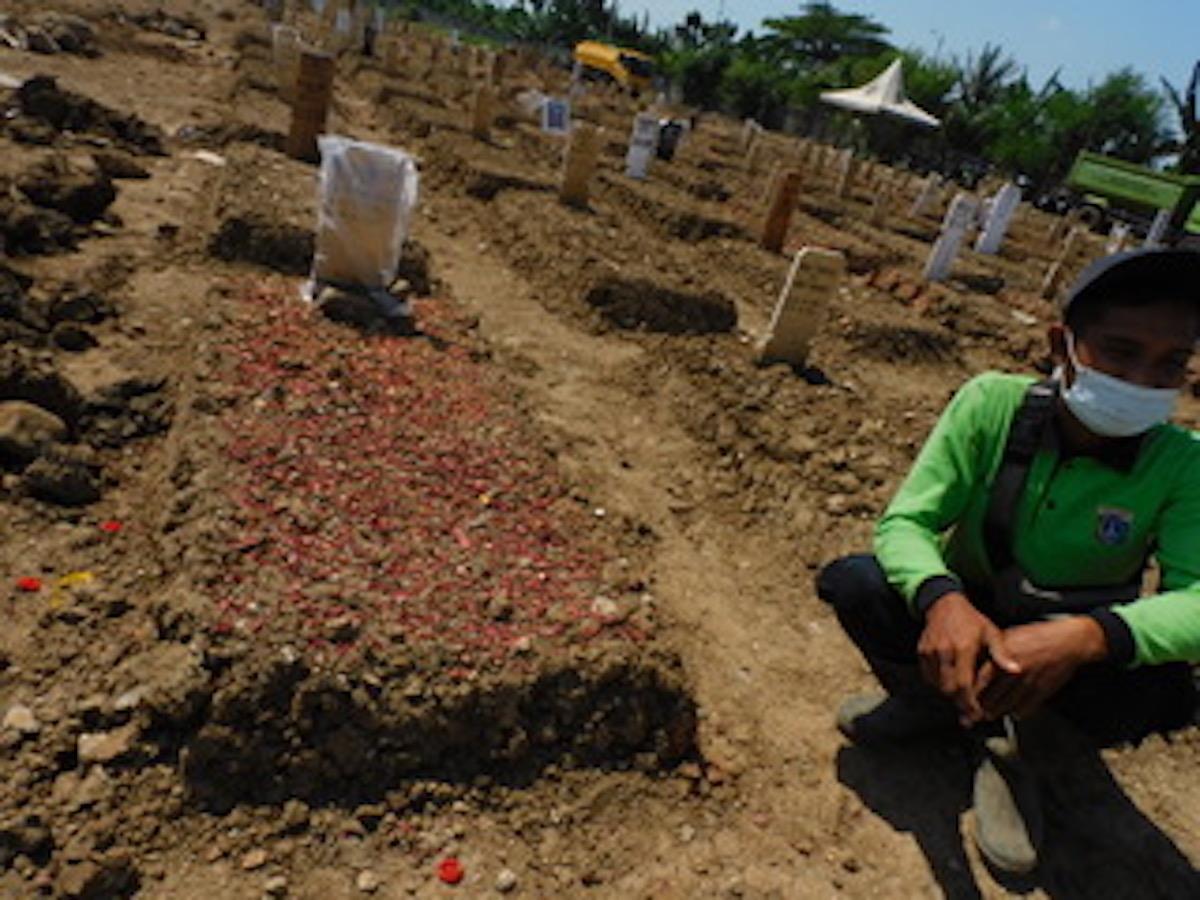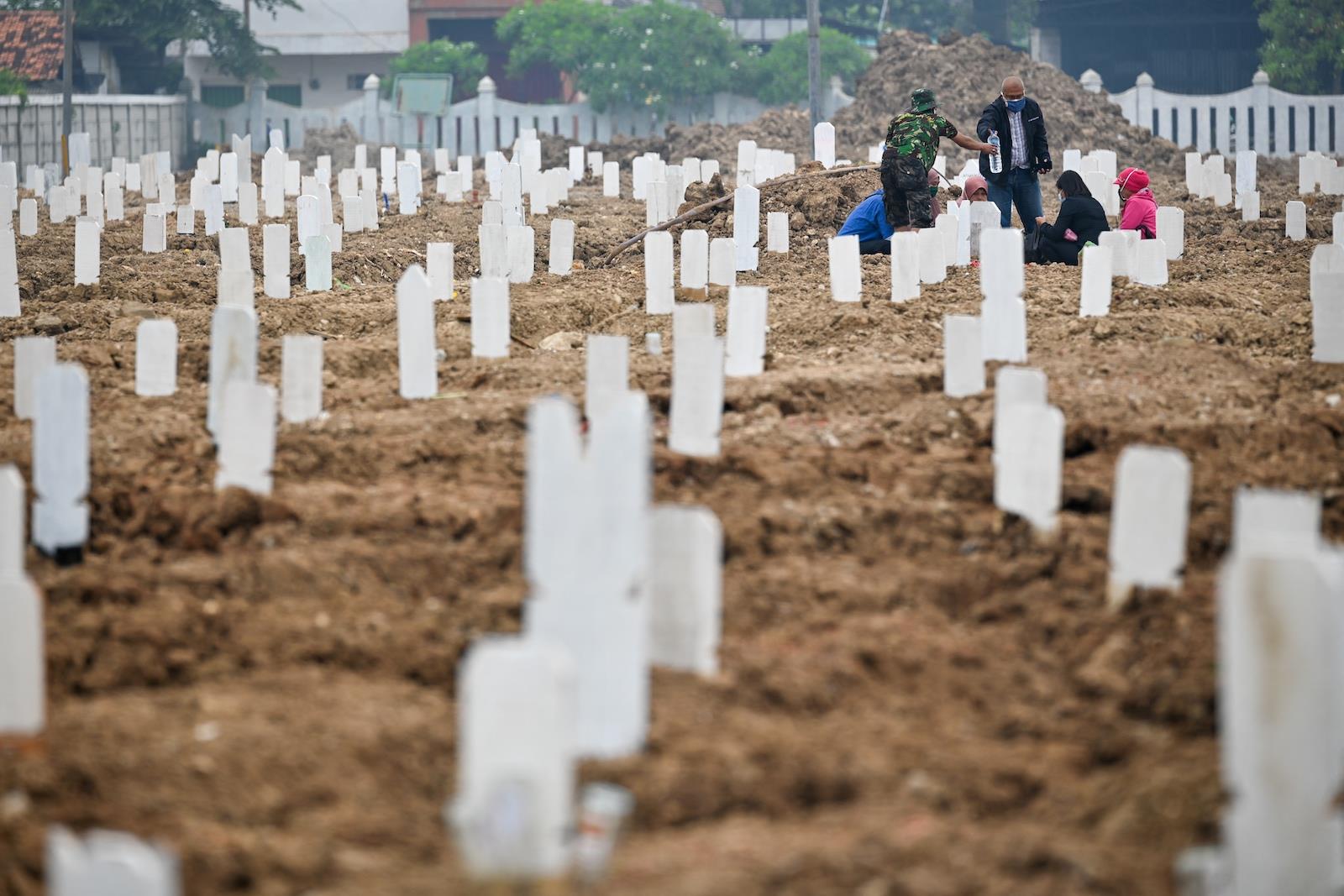(MENAFN- Asia Times) JAKARTA – Under the hot mid-afternoon sun, Syaiful shoveled the last heap of dirt on to a freshly dug grave before heading to a tent for his lunch break. But first he had to get out of his work clothes – disposable hazmat suit, face mask and gloves – before washing his hands at a makeshift outdoor pump.
Only then, squatting on the ground in the shade, was he ready to savor his simple meal of rice and vegetables wrapped in a banana leaf. He ate slowly and silently, as a loudspeaker from a nearby mosque blared out the names of the neighborhood's newly dead.
Syaiful is a gravedigger at Rorotan, a 22-hectare public cemetery in North Jakarta reserved solely for those who have died from Covid-19, now numbering nearly 11,500 around Jakarta city alone since the onset of the pandemic early last year.
It is the third and latest plot of government-owned land to be turned into a designated Covid gravesite. Since March this year when it first started taking in the spill-over from the other two Covid cemeteries, Rorotan has so far buried 5,000 victims.
Syaiful was drafted into his onerous new job without notice. He and more than 100 gravediggers across the Indonesian capital remain necessary but unseen workers in a scourge that has created so much sorrow and havoc in Indonesian lives. They live with it every day.
The gravediggers' work at the end of the Covid chain is backbreaking and, in many ways, no less hazardous than it is for the doctors and nurses on the frontlines of the pandemic. Yet, they get scant attention.
Occasionally, they receive donations of lunch boxes and care packages filled with extra face masks and vitamins to help keep up their defenses. So far, none of the 35 gravediggers at Rorotan have been infected.

Gravedigger Syaiful at the Rorotan Cemetery outside of Jakarta. Photo: Yuli Ismartono
Rorotan is a grim reminder of a pandemic that has claimed more than 83,000 deaths nationwide and overwhelmed a healthcare system unprepared for an onslaught of such magnitude.
Ironic, perhaps, for a country that has gone through earthquakes, volcanic eruptions, landslides and other natural disasters over the past 20 years. But few government leaders would ever have imagined something like this in their lifetimes.
The Joko Widodo administration does share some of the blame for failing to anticipate the latest surge in new daily Covid cases, which rose from as low as 2,600 in mid-May to a peak of 54,500 in mid-July in the wake of the post-Ramadan holiday.
While new infections appear to have evened off, the death toll has not. On July 28, 2,069 people died, according to official figures, the highest toll so far and a clarion call for the government to redouble its vaccination efforts.
If the messaging has been unclear and officials have at times appeared to have been playing by ear, some of the responsibility rests with the people themselves and their initial reluctance to accept Covid as a threat to their lives.
Living hand to mouth, low-income workers and other members of Indonesia's large informal sector could not rationalize the restrictions. While the government provided care packages, their delivery was irregular and deemed unsatisfactory.
Lax in implementing testing and tracing, the government's healthcare system wasn't up to the task. Hospitals ran out of rooms and life-saving oxygen supplies. Many of those who couldn't find a bed would end up at Rorotan.
When we encountered Syaiful there, he had just buried his tenth body of the day – still a far cry from the 233 burials on July 8.“It was a nightmare,” he recalled of that day. I started work at 7:30 in the morning and didn't stop until after midnight.” The following day was slightly better with 220 burials.

Funeral workers lower the coffin of a victim of the Covid-19 coronavirus at Rorotan cemetery in Jakarta on July 22, 2021. Photo: AFP / Bay Ismoyo
Syaiful said it was eerily unnerving as an unending line of ambulances and hearses arrived to deliver the victims, weeping wives, husbands, sons and daughters standing in the cloying mud to make their last farewells.“It was like an assembly-line burial, so impersonal.”
Machinery was brought in to dig the holes, never quite catching up with the procession of death. Wrapped in clear plastic, as required by health authorities, the wooden coffins were lowered into the waiting graves.
Then and now, it is only after Syaiful and his co-workers have completed the interment that grieving family members are allowed to venture close to the mound, offer prayers and strew flowers.
They are given a plain wooden plank, in which to write the name of the departed, along with their birth and death dates. There is no space for any words of farewell.
It is not the physical side of the job that affects Syaiful the most. Strictly enforced protocols only allow five family members to attend a burial. At times, it has been a problem.
“Some insist on more family members crowding around the burial site, and this ends up in a tense situation, either with harsh words being exchanged or a lot of tears,” says Syaiful, torn between being human and doing his job.
He has learned much about how the pandemic has affected families and their failure to recognize the danger signals because they had never experienced anything like this before.

Family members visit their relative's grave at a cemetery for Covid-19 coronavirus victims in Rorotan, Jakarta, on July 22, 2021. Photo: AFP / Bay Ismoyo
Take 47-year-old Puji who lost her husband because she thought he just had the flu – until he started having breathing difficulties and had to be rushed to hospital.
A week later, his condition worsened, but the hospital ran out of oxygen and had to order from outside. It did not arrive in time to save him. How was he infected in the first place? Puji thought it must have been at the factory where he worked. It is now clear many factories have ignored health precautions.
A brief glance at the rows of wooden grave markers shows most of the dead were over 50 years of age. Not all though. Syaiful points to the burial site of a 17-year old boy, which he remembers as being a particularly sad case.
The young victim's mother shared with Syaiful the last telephone message exchange she had with her son a day before he died.“She kept encouraging him to be strong, and he was describing the pain he felt trying to breathe,” he recalled. Like other hospitals, this one had run out of oxygen too.
Some of those buried at Rorotan were unable to get into a hospital, ending their days at home. The private watchdog organization LaporCovid estimates some 2,700 have so far died in isolation, apparently excluded from the official death list.
Rorotan is open to citizens from all religions. Christian gravesites stand out from those of Muslim victims with their distinctive white crosses in a cemetery that almost resembles a construction site, devoid of grass and trees.
There isn't much paperwork required to bury the dead here. A death certificate from the hospital or an ID card are enough to gain a last resting place in Rorotan, free of charge.

An aerial view of graves being prepared for victims of the Covid-19 coronavirus at Rorotan cemetery in Jakarta on July 22, 2021. Photo: AFP / Bay Ismoyo
At least for the next three years. After that, the Jakarta municipal government will charge families an annual fee of 40,000 rupiah (US$3) to help maintain the cemetery.
It is more complicated for those who seek to bury their dead outside the designated cemeteries. Not only do they need the obligatory death certificate, but they must also get written permission from the district office where the desired gravesite is located.
The reason? Neighborhood residents might object to a Covid victim being buried in their midst because of the irrational stigma that is often attached to this long procession of misery.
MENAFN01082021000159011032ID1102549827